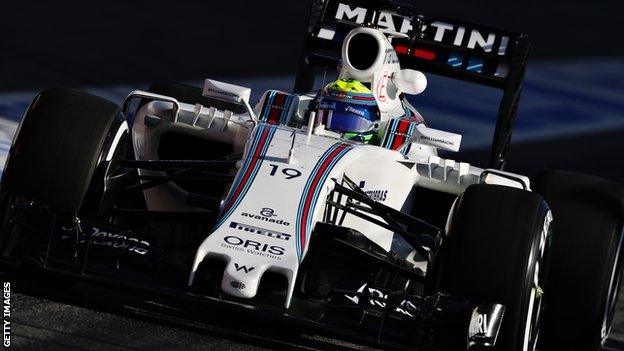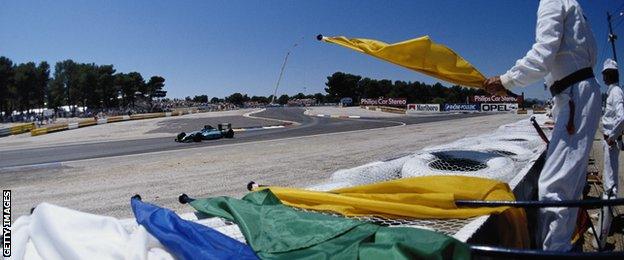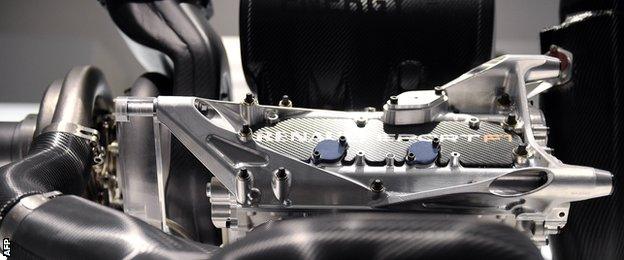Formula 1: A BBC Sport beginner's guide to the new season
- Published

New to Formula 1 but keen to learn more? You've come to the right place.
BBC Sport has compiled this handy F1 guide to answer all your questions about the 2016 season.
The race weekend
There are a record 21 races in 2016, starting in Australia on 20 March and ending in Abu Dhabi on 27 November.
The winner of each race receives 25 points, with the lowest-scoring position - 10th - receiving one point.
Points awarded at Formula 1 race weekends | |
|---|---|
1st - 25 points | 6th - 8 points |
2nd - 18 points | 7th - 6 points |
3rd - 15 points | 8th - 4 points |
4th - 12 points | 9th - 2 points |
5th - 10 points | 10th - 1 point |
A race weekend consists of three practice sessions, qualifying and the race itself.
On Fridays (Thursday in Monaco) there are two 90-minute practice sessions, with a 60-minute session on Saturday morning ahead of a 60-minute qualifying session on Saturday afternoon.
There are three stages to qualifying - Q1, Q2 and Q3: In Q1 drivers have 18 minutes to clock a fast time. The six slowest cars are eliminated once time runs out and will start the race in the final six places on the grid.
In Q2 times are reset and the remaining cars participate in a 15-minute session with the aim of recording a time that will secure their place in the top 10. The six slowest cars are eliminated and fill places 11 to 16 on the grid.
For the final part of qualifying, Q3, times are once again reset and the remaining cars have 12 minutes to clock their fastest possible time as they compete for pole position for the race, as well as the remaining nine places on the grid.
The race itself cannot exceed two hours, unless it is red-flagged - stopped because of an accident or poor track conditions. In such circumstances the total duration of the race and any red-flag stoppages cannot exceed four hours.

Flags are used to communicate vital messages to drivers. These include but are not limited to: yellow flag (slow down, don't overtake), green (track is clear), red (session suspended), blue (a faster car wants to overtake), chequered (session ended), black + car number (return to pits/disqualification)
Tyres
All F1 cars use tyres from a single supplier, currently Pirelli,, external which has a range of five dry-weather compounds - up from four last year. These are the new ultra soft (distinguished by purple sidewall markings), super soft (red markings), soft (yellow), medium (white) and hard (orange).
Pirelli now make three of their dry-weather tyre compounds available at each event. Pirelli allocates two sets of tyres for the race - only one of which must be used - and one set which can only be used in Q3. Each driver then chooses 10 further sets from the three compounds to take their weekend allocation to 13.
Two different dry-tyre compounds must be used during the race, unless it rains and one or both of two wet-weather compounds are used. These are know as the intermediate (with green sidewall markings) and full wet (blue).
At the start of the race, the cars that qualified for Q3 must be fitted with the tyres on which the driver set his fastest time in Q2.

The new purple-walled Pirelli ultra soft tyre will offer teams more strategy options
Engines
Since 2014, an F1 car's power has been provided by a 1.6-litre turbocharged V6 engine, which produces around 600 brake horsepower, with an additional 160bhp coming from an advanced energy recovery system (ERS), which converts mechanical and heat energy into electrical energy.
Each car is limited to 100kg - or about 130 litres - of fuel per race and engines must consume fuel at no more than 100kg per hour.
The number of engines each driver is allowed to use over the course of the season has increased from four to five, due to the rise in the number of races from 19 to 21.

New 1.6 litre V6 turbo engines including energy recovery systems were introduced in 2014
Aerodynamics
The aerodynamics of an F1 car have two vital jobs on the racetrack - producing downforce and limiting drag.
Downforce pushes the car's tyres into the road and helps it travel faster through the corners, while reducing drag - the wall of air resistance the car disturbs as it races forward - and also helps increase straight-line speed.
Every single surface of an F1 car can affect its aerodynamics and maximising efficiency is crucial to a team's success on the track. As a consequence, data is constantly examined and evaluated by teams throughout a race weekend as they look to get the edge over their rivals.

Front and rear wings - key aerodynamic components - did not appear on F1 cars until the 1960s
Teams and drivers
Eleven teams will compete in F1 in 2016. Each team names two race drivers for each round of the championship. They compete individually in the drivers' championship while their combined points go towards the team's tally in the constructors' championship.
The driver and team with most points at the end of the season are crowned world champions.
Three drivers will make their F1 debuts in 2016: Britain's Jolyon Palmer will drive for the re-formed Renault team while Indonesia's Rio Haryanto and German Pascal Wehrlein have been given the nod by Manor.
There is also a new team on the grid in 2016, with Haas F1 becoming the sport's first American constructor in 30 years. Their drivers are Romain Grosjean and Esteban Gutierrez.
Lewis Hamilton is the current champion, his 2015 crown added to the titles he won in 2008 and 2014. There are four other former F1 champions on the grid in 2015: Sebastian Vettel (winner in 2010, 2011, 2012 and 2013), Fernando Alonso (2005, 2006), Kimi Raikkonen (2007) and Jenson Button (2009).
Mercedes are the reigning constructors' champions after winning 16 of 19 races last season. Other previous constructors' title winners are 16-time champions Ferrari, nine-time winners Williams, and McLaren, champions on eight occasions.

The first champion: Giuseppe Farina won the inaugural F1 World Championship in 1950
History
The Formula 1 World Championship, which began in 1950, was borne primarily from the grand prix motor races that became popular around Europe in the 1920s and 1930s.
The first F1 grand prix was held at Silverstone on 13 May 1950, since when more than 900 races have taken place.
The sport's first champion was 44-year-old Giuseppe Farina, while the winner of the first constructors' title (which was not awarded until 1958) was Vanwall.
Michael Schumacher holds the record for most drivers titles (seven) and race wins (91) while Ferrari lead the way among constructors with 16 titles and 221 victories.
- Published8 March 2015

- Published6 March 2015

- Published6 March 2015

- Published7 March 2015

- Published18 December 2015

- Published2 November 2018

- Published26 February 2019
